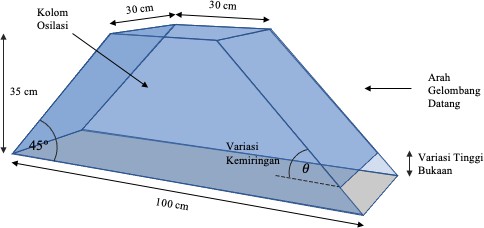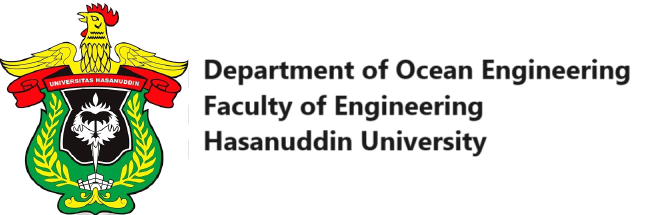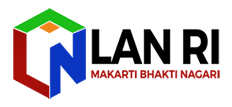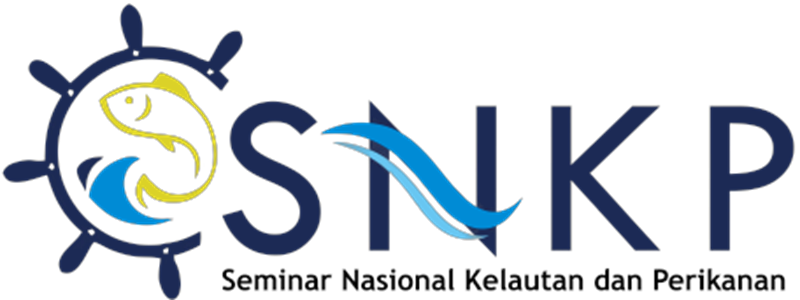Experimental Study of the Relationship between Slope and Opening Height of OWC Type Wave Breaker Model on Wave Reflection
DOI:
https://doi.org/10.62012/zl.v5i2.35402Keywords:
Breakwater, OWC type Breakwater, Reflection CoefficientAbstract
Breakwater is a very effective wave dampening building to be used as a coastal protection against coastal abrasion by destroying wave energy before it reaches the coast. The working mechanism of the OWC type is the rise and fall of ocean waves which will push the air in the OWC column, then will rotate the turbine connected to the generator to produce electricity. This study aims to determine the effect of slope and opening height on breakwater on wave reflection. Then analyze the parameters that affect the amount of wave reflection and compare the resulting wave parameters. This research was conducted at the Hydraulics Laboratory, Department of Civil Engineering, Faculty of Engineering, Hasanuddin University. The method used was experimental based. The resulting wave characteristics consist of three depth variations, three period variations and three stroke variations. The research model used is an Oscillating Water Column (OWC) type breakwater with slope variations of 45°, 60° and 90° and open wall variations as high as 5 cm, 10 cm and 15 cm. The reading of the water level fluctuation is done electronically through the reading of the wave monitor. The results showed that the magnitude of the reflection coefficient is influenced by structural parameters, namely the slope and height of the model opening and hydraulic parameters, namely depth, period and wave height. The effect of the model slope on the reflection coefficient is that the greater the slope, the greater the reflection coefficient value. The effect of the model opening height is that the greater the opening height, the smaller the reflection coefficient value.Downloads
References
Cintya Fandani, Rivaldi David Maulana, Helen Purnomo, Natasya Shaherani, Robby Hilmi Rachmadian, and Tasya Khairunisa, Pengembangan Fitur 360o Virtual Tour Berbasis Virtual Reality (VR) PadaAplikasi Banyuwangi Tourism Sebagai Upaya Peningkatan Kualitas PromosiPariwisata Kabupaten Banyuwangi, no. July. 2020. [Online]. Available: https://www.researchgate.net/publication/353338612
I Made Adi Sayoga and Made Nuarsa, “Pemerataan Energi Gelombang Laut Dengan Sistem Berpiston Aksi Ganda,” Din. Tek. Mesin, vol. 3, no. 2, pp. 106–110, 2013.
S. R. Utami, “Studi Potensi Pembangkit Listrik Tenaga Gelombang Laut dengan Menggunakan Sistem Oscillating Water Column (OWC) di Tiga Puluh Wilayah Kelautan Indonesia,” Dep. Tek. Elektro Fak. Tek. Univ. Indones., 2010.
H. Al Imran, M. Arsyad Thaha, Mu. P. Hatta, B. Bakri, Nenny, and Kasmawati, “Pengaruh Tinggi Gelombang Terhadap Tekanan Pada Pompa Gelombang Tipe Pelampung,” Ranc. bangun, vol. 07, no. 2, pp. 42–46, 2021, [Online]. Available: https://journal.unismuh.ac.id/index.php/hidro/article/view/6011
R. Karamma, A. Ashury, N. Karim, and A. Almunawir, “Studi Laboratorium Disipasi Dan Refleksi Gelombang Pada Susunan Pipa Sebagai Pemecah Gelombang,” Ris. Sains dan Teknol. Kelaut., no. c, pp. 28–33, 2019, doi: 10.62012/sensistek.v2i1.13082.
A. Kusumastuti, “Pengenalan Pola Gelombang Khas dengan Interpolasi,” CAUCHY J. Mat. Murni dan Apl., vol. 2, no. 1, pp. 7–12, 2011, doi: 10.18860/ca.v2i1.1803.
B. Triatmodjo, Teknik Pantai. Yog: Beta Offset, 2016.
F. Akbarrizky, R. Munadi, and H. Walidainy, “Perancangan dan Pengujian Antena Microstrip Circular Patch Array Dua Elemen untuk Aplikasi Wimax 2,3 GHz,” J. Komputer, Inf. Teknol. dan Elektro, vol. 2, no. 4, pp. 21–28, 2017.
M. K. Humairah, S. Widada, and R. Widiaratih, “Simulasi Model Fisik Efektivitas Pemecah Gelombang Tetrapod Dan Dolos,” J. Tek. Hidraul., vol. 13, no. 1, pp. 17–26, 2022, doi: 10.32679/jth.v13i1.660.
A. O. P. Putra, H. D. Armono, and Sujantoko, “Pengaruh Elevasi Muka Air Laut Pada Koefisien Transmisi dan Refleksi Composite Breakwater,” J. Tek. ITS, vol. 2, no. 1, pp. G47–G51, 2013, [Online]. Available: http://ejurnal2.its.ac.id/index.php/teknik/article/view/3106

Downloads
Published
How to Cite
Issue
Section
License
Copyright (c) 2024 Riswal Karamma, A.Subhan Mustari, Mukhsan P.Hatta, Silman Pongmanda, Ariningsih Suprapti, St.Nur Rahmah, Muhammad Rifaldi Mustamin

This work is licensed under a Creative Commons Attribution 4.0 International License.
Allow anyone to modify, improve, and make derivative works, even for commercial purposes, as long as they credit to you for the original work.




























